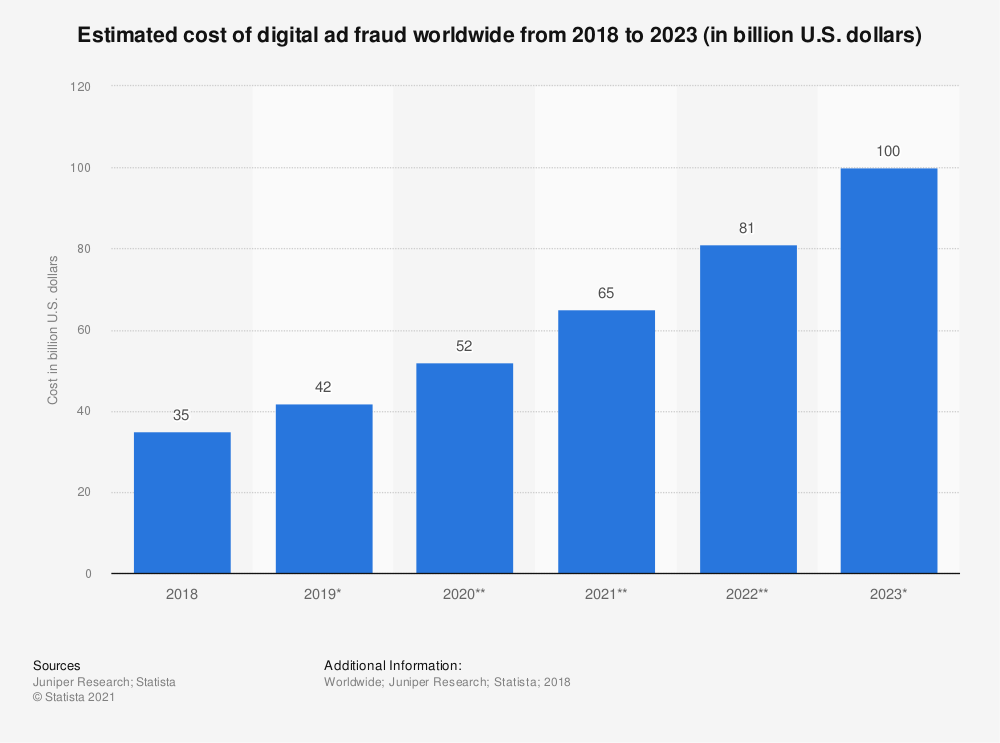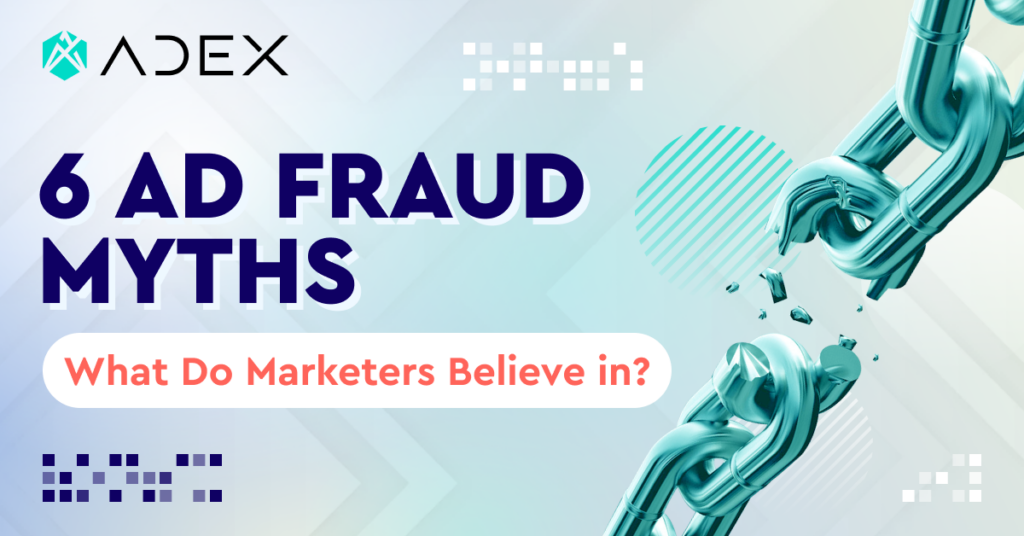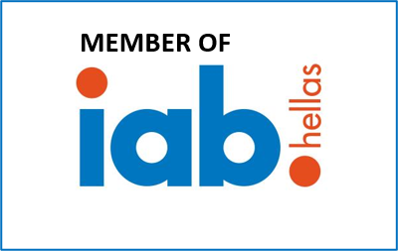The real disaster has all chances to happen when you fail to estimate risks adequately and miss the chance to take timely actions and prevent a catastrophe. This is exceptionally true for the ad fraud issue. Why so? Because numerous marketers choose to believe in calming myths instead of facing a problem. As a result, they lose money.
Statista’s research shows that in 2022 ad fraud loses reached 81 BLN dollars already and the forecast for 2023 is 100 BLN dollars:

If you still believe in one of the myths discussed below, chances are that you didn’t have to deal with fraud consequences yet. You may believe that ad fraud is not a big deal only in case bots didn’t gulp a significant part of your budget so far or… you might have ignored the issue. Read the common myths about ad fraud and think about changing your attitude if at least one of them is appropriate for you.
Myth #1: “I didn’t have any fraud before, so I won’t have it in the future”
The first most common myth sounds like this. Advertisers who didn’t experience (or in most cases — just overlooked) fraud today believe that they won’t face it tomorrow. Unfortunately, this is a common logical fallacy.
In reality, previous events are not direct predictors of future ones. Even if you avoid any experiments and stick to a single traffic source, it doesn’t mean that you are entirely safe, as well.
If your campaigns were fraud-free last year, there are no guarantees that you are protected this year. Bots become more and more advanced and their invasion strategies are high-tech and hard to deal with, since they are hard to distinguish from real people. This tendency is about to go on and on.
Myth #2: “I buy premium traffic directly from publishers, so it’s fraud-free”
If you remember our interview with Eugene Klimshin, one of ADEX partners, he said that he used to cooperate with reliable networks to purchase traffic and didn’t have any idea about fraud at all. After he started using our API feature for real-time fraud detection, he managed to block millions of fraud traffic sources he never suspected before.
Fraud is prevalent in programmatic buys, but it is also widespread in direct deals. It’s no secret that unreliable publishers intentionally buy low-quality traffic in order to show off and demand more money from advertisers.
However, unfortunately, premium traffic can also be affected. Buying directly from publishers is not a guarantee that you won’t face fraud. Even trustworthy publishers can accidentally provide you with bot-flooded traffic just because they have no idea about the issue. Say, there are situations where publishers buy traffic from third parties and somehow bots sneak into it. Unfortunately, a good reputation of a chosen publisher does not exclude fraud.
Myth #3: “My campaign is small, no fraudsters care about it”
Sad but true: it doesn’t matter if your campaign is big or small, in both cases you can become a victim of fraud. Let’s make things clearer: fraudsters are less interested in small campaigns with decent budgets, but this doesn’t mean that you are not prone to bot attacks at all.
At the same time, sometimes small campaigns suffer from non-broad fraud attacks even more seriously. If your cost per click is non-expensive, like a couple of cents or a dollar, it may seem that losing such a small amount is not a big deal. Still, imagine bots clicking your ads a thousand of times, which can cost you… thousands of dollars.
In general, no matter if your campaign is big or small, you can still experience ad fraud and its harmful consequences.
Myth #4: “I stick to conversions, bots cannot fake them”
The problem with modern bots is that they are really hard to distinguish. As we have already warned you in our previous articles, bots become more and more humanlike. What is even worse, they can run on infected devices owned by real people. This way, bots’ behavior can mimic real attribution models, because they “know” how to use real cookies and device IDs.
Say, messing up with cookies, namely – cookie stuffing, is one of the most widespread fraud strategies today. Most advertisers believe that retargeting is always bot-free, because such ads are shown to those users who have already made a purchase. Sadly, but you cannot rely on cookies in such a situation — if a cookie has been assigned to a certain device, it doesn’t guarantee that the latter visit will be the same cookie.
Bots can act in a background regime of an infected device, eagerly watching the ads and performing target actions day and night, so that the device owners will never find out about that. Some advanced bots can access real cookies, so even if the user’s behavior looks like a real one, it doesn’t mean that it’s not a bot trying to act like a human user.
Myth #5: “Google blocks any fraudulent activity, so my ads are safe”
Some advertisers believe that Google prevents any fraudulent activity, which ensures their safety. However, that’s not how it works.
Yes, Google has fake click detection, but they don’t really stop fraud. Using Google services, you can view stats and see suspicious activity around your ads. If you are lucky, you can even ask for a fake traffic refund. Still, such tracking is not real-time, which means that you lose your budget first and then you have a slight chance to get some cash back.
And here is a head scratcher. Google charges money for clicks, making most of their revenue from paid search. Now think about it: are they really interested in telling you which portion of your clicks was fake?
Myth #6: “I check stats to detect fraud, so I am protected”
You can still be vulnerable to fraud, even if you have an anti-fraud software, namely — the one that informs you about fraud that has already happened. While detecting the signs of fraud and learning more about the issue is important, it’s not the best way to save your money.
Let’s imagine that you checked your campaign results and your anti-bot solution informed you that some sources were not reliable enough. So you block them and stop cooperation. However, the budget is already spent, bots have already done harm to your ads, and the chance is wasted.
What should you do?
Real-time fraud detection and prevention is something that can save your campaigns from bot attacks. And ADEX is always by your side to provide it! You can rely on our features for real-time reporting, immediate fraud alerts, and expert analysis. ADEX delivers a full-fledged anti-fraud system able to save your campaigns from numerous types of fraud.
So don’t rely on myths and false sense of security — create an ADEX account today and keep your ads safe from criminals!


